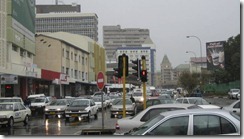We arrived in Namibia on an evening flight from Johannesburg, South Africa in April 2011, and drove to Windhoek, the capital and largest city, in the middle of a torrential rain typical at the end of an African rainy season but somewhat unusual for a dry country like Namibia. The rains wreaked havoc on the relatively smooth tarred highway, leaving behind gaping potholes that tested the suspension of our sub-sub-compact Nissan car rental not much bigger than a Mini. For a reason I can only chalk up to terrain or available land, Hosea Katuko International Airport sits far out of town in the middle of nowhere. Heavy rain and darkness obstructed my view as we drove on in a car that offered the challenge of driving for the first time in manual left-hand drive vehicle in an unknown location.
We arrived in Windhoek, a city of about 500,000 residents, late at night and dead tired after a long afternoon of commuting from our home in Zambia. The complimentary maps of Namibia and Windhoek given to us by the car rental company helped us locate the general vicinity of our hotel, the Protea Thuringerhof, on the city’s main thoroughfare, Independence Avenue. Contrary to the stereotype that men don’t stop to ask for directions, I stopped and asked where we were at a downtown petrol station. We were off by a couple of blocks. GPS with African coverage would have been helpful, but alas we did not have one at our disposal. Because the hotel is in the center of the city, we were concerned for our safety in a nearly deserted part of town. Fortunately, we weren’t in any imminent danger. Windhoek has a reputation for being a relatively safe African city far different from its neighbor, South Africa, where violent crime and carjackings are far too common.
Protea Hotels is a mid-scale (3-4 star) South African chain virtually omnipresent in cities throughout southern Africa. The quality varies by property, as we soon found out. The Thuringerhof where we stayed is centrally located and was cheaper but decidedly no frills and lacking in ambience; its sister property, Furstenhof, is more expensive but may be a better option for those looking for comfort. The Thuringerhof was obviously an aging hotel that Protea had purchased and remodeled. We received a discount during our stay because the hotel was painting the hallway and room on our floor and had covered the hallway with tarp plastic. The elevator was also broken. Porters carried our luggage up and down several flights of stairs from the postage-stamp sized fenced parking lot adjacent to the basement. We can’t really complain because the price was right in a country where lodging can cost $400-$500 per night, and the hotel was merely a base from which to explore the city. The complimentary breakfast each morning let us pore over our maps and plan our sightseeing strategy for the day. If you visit Windhoek on vacation, consider staying at the Thuringerhof if you place a premium on affordable lodging in a good location and can dispense with any other amenities.



[…] Windhoek, Namibia (part one) « World Adventurers […]